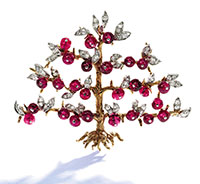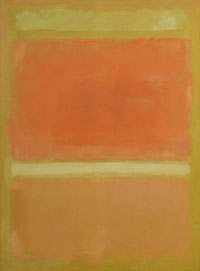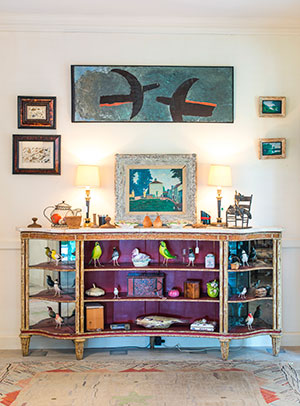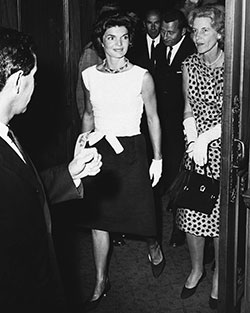A cultivated taste: the Bunny Mellon auction
Simply sign up to the Life & Arts myFT Digest -- delivered directly to your inbox.
Before her death, few things were publicly known about “Bunny” Mellon, née Rachel Lowe Lambert. She was born in August 1910, and died in March this year, at her home, Oak Spring Farms, a 4,000-acre estate in Virginia. Referred to in the press as the Listerine heiress (her chemist grandfather invented the mouthwash, her father marketed it), she attended Miss Fine’s School in Princeton, and Foxcroft prep school in Virginia, and married twice.
Her first marriage, to the businessman, horse breeder, farmer and yachtsman Stacy Barcroft Lloyd Jr, produced two children and ended in divorce in 1946. Her second marriage, two years later, to the banking scion and widower Paul Mellon, provided her with two stepchildren and one of the world’s greatest fortunes (the exact size of her fortune has long been obscured by family settlements and trust funds).
An avid gardener, she was given her first flower book, Flower Guide: Wild Flowers East of the Rockies, by her grandfather when she was 11, by which age she was already making amateurish garden designs. In 1962 she was commissioned to plant the White House Rose Garden for President John F Kennedy.
Much else about her was – and remains – known only to her confidantes. Unlike those society hostesses who throw their doors open to photographers, wardrobes open to fashion magazines, and address books to biographers, Bunny Mellon shrank from such attention. “That just wasn’t of any interest to her, to be in the public arena,” says Alex Forger, her lawyer (and the executor of her estate), who met Bunny in the early 1970s and remained friends with her for 40 years. “She was more interested in climbing trees than in climbing the social registers.”
…
Together, the Mellons occupied a rarefied social elite that seldom invited strangers into its midst and held the view that one’s most prized possession should be one’s privacy. They entertained often but exclusively – a typical lunch party might include Noël Coward, Adele Astaire, President Kennedy and his wife Jackie. Bunny granted only two interviews during her lifetime: the first, to the New York Times in 1969, was to counter rumours surrounding her husband’s fidelity; the second, in 2010, to Vanity Fair, was conducted in the wake of the scandal surrounding personal payments she had made in support of presidential candidate John Edwards, some of which had been used, without her knowledge, for the benefit of his lover and illegitimate child.
The 1969 interview is remarkable for her observation: “Nothing should be noticed . . . Nothing should stand out.” It was her personal creed. She was most often photographed walking through her garden, her back turned to the lens. “When I am photographed, I sort of squint up my eyes so it all goes away,” she explained to the New York Times of her aversion to the camera. She is survived by her son, stepchildren and several grandchildren, but the family have assumed the same mantle of silence.

Despite these spare facts, a much rounder, more generous, picture of Bunny Mellon is emerging thanks to the sales of her belongings, which are being auctioned at Sotheby’s, New York. All the proceeds will go towards the Gerard B Lambert Foundation, a trust established by Bunny to preserve the vast horticultural library she built at Oak Spring Farms. An extraordinary collection, it has revealed not only a woman with an exquisite talent for spending money but also an unlikely tastemaker and loyal friend whose influence reached far beyond the grounds of her private retreats.
“She loved a good story, she loved fairy-tales and she loved secrets,” says Forger. “She loved looking at astrology or talking to someone called a witch. She had a great sense of humour – she and Jackie were trading secrets and giggles back and forth. But the world does not know her. And that’s the way she liked it.”
The Mellons “had this great passion”, says the art dealer Franck Giraud, who first met Bunny in the late 1980s and started working for her after Paul’s death in 1999. “They were buying to surround themselves with the things they loved. He was an Anglophile, she was a Francophile. He loved horses. And she loved . . . lots of things.”
Together, at Oak Spring in Upperville, Virginia (one of their seven properties, including a flat in Paris, a New York townhouse and homes in Antigua and Nantucket), the couple amassed one of the world’s great private art collections. Paul liked to buy works by impressionists and Old Masters. Bunny liked everything else. She had an eclectic eye, and was as likely to fall in love with a naive 19th-century farm painting, or an ostensibly worthless hook rug, as she might a modern masterpiece.

Nevertheless, they owned no shortage of masterpieces. At the Impressionist and Modern Art Auction sale at Sotheby’s, on Monday, 43 works from the Mellon collection were sold, including a painted bronze table, by Diego Giacometti, that was commissioned by Bunny for her house in Antigua (to go alongside a matching chandelier in which the local birds might nest) and a Mark Rothko painting she had picked up from a pile of unstretched canvases at his 69th Street studio in New York. “It was like looking at rugs on the floor”, she later told Giraud.
Over the years she accumulated 17 Rothkos in all – a 1970 blue abstraction sold for nearly $40m, twice its estimate; another from 1955, “Untitled (Yellow, Orange, Yellow, Light Orange)”, shown left, was sold to the Nahmad Gallery for $36.5m; Richard Diebenkorn’s sunset abstraction “Ocean Park” was bought by the fashion designer Valentino for $9.68m; and Georgia O’Keeffe’s “White barn” (1932), which had once hung in Bunny’s dining room, fetched $3.1m.
Bunny didn’t only buy canvases. This month’s remaining three sales contain further mind-bogging treasures – rare Meissen dining services, porcelain tableware in the shape of asparagus spears and lettuce heads, Cartier jewels, Rolex watches, immaculate Regency furniture, a set of walking sticks, farm basketry, and weather vanes.
Not only did Bunny Mellon have “great everything”, as Giraud describes it, she had a radically artless way of keeping it. For those sent to Oak Spring to archive the collection, the search was an illuminating treasure hunt; a cupboard drawer revealed a cache of silver snuff boxes, a Pissarro was found propped up on a bedroom chair, priceless furniture was found alongside farm machinery.
Even Giraud, who knew about the collection but less of its location, marvelled at the insouciance of Bunny’s hanging a still life by Van Gogh in the bathroom where it had been gently steamed for years. “I gathered all the pictures in one room,” he says, “and when the conservator looked at the Van Gogh, she said the condition was really good!”
Oak Spring was no ramshackle mess. On the contrary, each item in the house had been perfectly, exquisitely placed: it was simply that Bunny denied “important” works a higher decorative status. Hers was an attitude, Giraud argues, born of limitless means. Given she could buy whatever she wanted, she placed value only on those things that pleased her: price was irrelevant. “You can always judge a collector by what they hang in the bedroom,” he says. “She had the Van Gogh in the bathroom, and in the living room, in Antigua, she had a poster from a Rothko exhibition.”
Bunny’s acquisitive appetite stretched from her horticultural manuscripts to her sweater drawers. When her couturier, the legendary Spanish Basque designer Cristóbal Balenciaga retired in 1968, he personally took her and Jean Schlumberger, the French jeweller and Tiffany designer who made fastenings for Bunny’s bags, across the road to the atelier of Hubert de Givenchy. She had considered going to Yves Saint Laurent but Balenciaga was adamant that only Givenchy would do. Speaking on the phone from his home in Paris, the 87-year-old designer remembers: “She was very shy, very timid. I never thought she would order any clothes from me. But the next collection we sent off sketches and samples and . . . she ordered a lot of clothes.”
Bunny Mellon’s sartorial relationship with Givenchy was such that the designer kept a special dressing room dedicated to her at his salon, and the two became close. He indulged her desire for navy blue, and simple, elegant designs, to her own specifications; she reciprocated with conversations about art, gardening and the natural world.
“She was spoilt by a marvellous life,” says Givenchy today. “But she was intelligent, and open. The spirit she had was her very own spirit. In my studio she’d see the colour and the fabric, and she’d say, ‘Oh, I’d love to have a dress in that fabric. Can’t you make something special for me?’ ”
As well as the “something specials”, Givenchy was also tasked with making her gardening hats. “I made hats in denim, and jean, and cotton. Because Bunny bought quantity, you know? And sometimes, I’d say to her, ‘Bunny why do you need so many?’ And she’d say, ‘Because I may lose it – I may leave it out in the empty garage.’ ”
In 1996, when Givenchy was restoring the potager du roi, at Versailles, the Mellons made a huge contribution to the funds necessary to recultivate the Sun King’s vegetable garden, and Bunny took an active role in its planning and planting. “She was my best friend,” the couturier says. “We spoke twice a week until the end, and she was completely conscient. She always had another idea. And now, it’s difficult. I instinctively take the telephone and make the number to Virginia. But it’s finished.”

Those close to her say Bunny would have balked at being described as a tastemaker. “She had no intention of being one. She couldn’t care less,” says Giraud. Nevertheless, her stylish influence was felt. When Jackie Kennedy first visited Oak Spring, she was said to have been so in awe of Bunny’s elegant poise and domestic style, she announced: “I want everything you’ve got.” Bunny was subsequently called in to help design and redecorate the White House, where, according to Forger, “she helped Mrs Kennedy bring in historic furniture and create a wonderful environment of decorative art”.
Bunny’s social set was small but it was phenomenally powerful. “When she was committed to somebody, among the circles, she certainly made the promotion,” says Giraud. “She gave a number of close friends a bangle by Schlumberger. And when Schlumberger had an exhibition at the Wildenstein gallery in the ’60s, she made sure Jackie came in and opened the division. She used her influence discreetly to help a friend.”
Likewise with artists. “Once,” Giraud says, “they gave a big dinner at the National Gallery [in Washington], and she asked for [her] Rothkos to be hung around the room. At the time the National Gallery didn’t have a single Rothko.” Such an effort was not an attempt to manipulate the market – “She never sold a single one [except one, to a museum]”, Giraud says – she simply wanted “to make sure the gallery understood and saw those great pictures.”
Even though she continued to collect right up till the end – she took a late fancy to the vivid palettes of the Scottish colourists, such as John Duncan Fergusson – Bunny Mellon did reach an acquisitive threshold. “You know, Franck, I think I have enough of those,” she once told Giraud, following his announcement that a rare piece of blue and white porcelain was coming up for sale. Asked what jewellery she would like for her 50th wedding anniversary, she opted instead for a barn. Of some things, even she had enough.
…
It seems strange, then, to think of such a complete personal collection now broken up and parcelled up into lots. Stranger still that someone so protective of their privacy in life should have it so noisily invaded at their death. We can pore over the auction catalogues. We can ogle her jewellery. Thousands of visitors have shuffled past selected exhibits from the sale at Sotheby’s; still others will see her Schlumberger jewels at the Virginia Museum of Fine Arts, or her Balenciaga gowns, which have been returned to the Balenciaga Museum in the Basque Country. Bunny Mellon’s world is private no more.

Over the next few weeks, the gavel will disperse her collection in a few short minutes. As someone so instrumental in helping her accumulate it, does Giraud mourn its dissipation? “You have mixed feelings. It’s great that the foundation will be funded, which is really what she wanted.” He pauses. “They were very aware they were only the guardians of the art. It had a life before, and it will have a life after.”
Perhaps it’s only right that the legacy she cared most passionately about was not the fate of the porcelain but the preservation of her horticultural library, with its world-class collection of books and its focus on conservation. As Forger explains: “The library has the prospect of doing good things in terms of the sustainability of the earth, learning about the genesis of plants and trees and flowers, and how to care for the land.”
And it should be no surprise either to find her conservationist cause has itself become rather chic. Just as her radical art collection demonstrated an evolved taste way ahead of its time, so did her passion for horticulture and ecology predate the modern organic movement. “She was never out of style,” insists Forger. “Folks just didn’t recognise she was a leader of style to spend her life dedicated to nature.
“She came from an era in which she used to ride her pony and trap down Main Street in Princeton,” he continues. “And she was at her best when she would go with her clippers and casual, outdoor, walking clothes, in the garden, climbing trees and pruning. She was a very smart woman.” Indeed she was. In a gardening hat by Givenchy.
Bunny Mellon’s jewels and other objects are being auctioned by Sotheby’s, New York, on November 20-21 followed by an interiors sale from November 21-23, sothebys.com
Jo Ellison is the FT’s fashion editor.
Slideshow photographs: Fred R Conrad/ Eyevine; Darren S Higgins/ Eyevine; AP
Comments